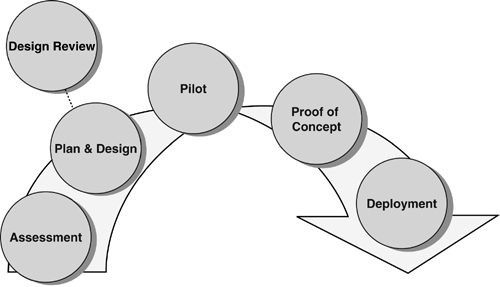Migration-The Big Picture
| < Day Day Up > |
Migration ”The Big PictureIn Chapter 1 I detailed important new features and fixes in Windows 2003 to help you take advantage of them in your enterprise and to leverage them in developing your business plan and cost justification, as detailed in this chapter. This chapter described migration methods , tools, and new features in Windows 2003 such as functional levels. Figure 3.30 illustrates the migration process. The chapters in this book are organized around this process to provide a logical flow and smooth transitions between stages in the plan. Let's review the key phases of the migration as noted in the diagram in Figure 3.30. Figure 3.30. The Windows 2003 migration path . The Design TeamChapter 4, "Assessment of the Enterprise," discusses the assembly of the design team. The membership of this team varies widely with each company, and Chapter 4 offers some sample teams and their backgrounds and roles to help you assemble yours. In addition to your company resources, it is very important that you engage the services of a qualified consultant who has had experience doing migrations that are similar to yours. Leveraging experience from other migrations, a consultant can save you a lot of time and money. Windows 2000 is mature enough that there are many consultants who can help, and Windows 2003 doesn't require a lot of updated skills. Make sure you get the right resource to handle your needs. For example, if you are deploying Exchange or clusters, it is important for you to validate the experience and reputation because a bad consultant can hurt your efforts. I have sat in on a number of design reviews where the consultant who was engaged (not from HP) gave bad advice. In one case, it required the complete reinstall of a forest with more than 1,200 locations. AssessmentAssessing your enterprise is critically important. The purpose is to evaluate the physical, logical, business, and to some extent, political environment of your enterprise. The easiest way to conduct your assessment is to create templates, and then fill in the information. After that is complete, you can simply gather the information into a single document: the Assessment Report. Chapter 4 is organized so that you can create the report using the table of contents as major headings in the report and then create templates for each heading. That chapter also digsinto the details of assessment topics and provides examples of assessments I've done that hopefully will give you some idea of the process. Plan and DesignThis is the design phase from which the AD Design and other design documents will be generated. Typically after the assessment is completed, an experienced consultant or anyone who has completed migrations previously will have a pretty good idea what the AD design should be. This includes:
Chapter 5 details the logical design, and Chapter 6 describes the process for the physical design of the enterprise. The AD Design will incorporate both of these aspects. Design ReviewI have been engaged in a large number of design reviews in which the customer had someone else (perhaps another company) create the AD design, and they asked me to review it. This really is a good practice because it lets an "outside" party who has not been involved take a more critical look at the design and try to poke holes in it. I've never yet found a design that I couldn't find something wrong with. Sometimes just my asking questions to understand the environment and design raises flags they hadn't considered before. Pilot and Proof of ConceptThe pilot is a test environment that often is designed to be phase 1 of the migration. Here we use live data and actual users and computers that are joined to the new domain. The pilot is described in Chapter 6, and the Georgia Department of Transportation's pilot is used as a sample. The purpose of the pilot is to stress the design to see if the policies produce the desired results, and to see if replication works properly and perhaps allows testing at remote sites. A well- conducted pilot will mitigate the risks and give a high probability of success to the migration. DeploymentThe deployment, or implementation phase, is simply an extraction of the pilot. Use the pilot to tweak and fix things, and then migrate the remainder of the users, computers, and groups. A carefully planned implementation that monitors changes introduced to the environment is necessary to make sure the migration is successful. Chapter 7 will give you some good ideas as to deployment of servers, and particularly ProLiant servers. Careful monitoring of this phase is essential. Support and ManagementObviously there must be management throughout the lifecycle of the project, and there must be support at the end. The support is not only your internal help desk, but also support for your IT staff. Having worked in the support industry for many years , a good share of our business comes from a consultant getting things set up and then when it breaks, no one knows what to do. Make sure you factor this into your migration plan. |
| < Day Day Up > |
EAN: N/A
Pages: 214
